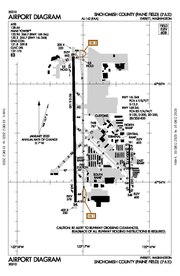
Back مطار باين فيلد Arabic مطار باين فيلد ARZ Snohomish County Airport CEB Snohomish County Airport German Aeropuerto de Paine Field Spanish پایگاه هوایی پین Persian Aéroport du Paine Field French ペイン・フィールド Japanese 페인 필드 Korean Paine Field Portuguese
Seattle Paine Field International Airport | |||||||||||||||
|---|---|---|---|---|---|---|---|---|---|---|---|---|---|---|---|
 | |||||||||||||||
 Aerial from southwest; August 2009 | |||||||||||||||
| Summary | |||||||||||||||
| Airport type | Public | ||||||||||||||
| Owner | Snohomish County | ||||||||||||||
| Serves | Seattle metropolitan area | ||||||||||||||
| Location | Everett, Washington, U.S. | ||||||||||||||
| Opened | 1936 | ||||||||||||||
| Time zone | PST (UTC−08:00) | ||||||||||||||
| • Summer (DST) | PDT (UTC−07:00) | ||||||||||||||
| Elevation AMSL | 608 ft / 185 m | ||||||||||||||
| Coordinates | 47°54′22″N 122°16′53″W / 47.90611°N 122.28139°W | ||||||||||||||
| Website | www | ||||||||||||||
| Maps | |||||||||||||||
 FAA diagram | |||||||||||||||
 | |||||||||||||||
| Runways | |||||||||||||||
| |||||||||||||||
| Statistics (2023) | |||||||||||||||
| |||||||||||||||
Seattle Paine Field International Airport (IATA: PAE, ICAO: KPAE, FAA LID: PAE) — also known as Paine Field and Snohomish County Airport — is a commercial and general aviation airport serving the Seattle metropolitan area in the U.S. state of Washington. It is located in unincorporated Snohomish County, Washington, between the cities of Mukilteo and Everett, about 25 miles (40 km) north of Seattle. PAE covers 1,315 acres (2.05 sq mi; 5.32 km2) of land.[1]
The airport was built in 1936 by the Works Progress Administration and began commercial service in 1939. It was named for Topliff Olin Paine in 1941, shortly before the Army Air Corps began the occupation of Paine Field for military use. The airport briefly returned to civilian use from 1946 through 1950 with service by West Coast Airlines before conversion into an air force base during the Korean War. In 1966, the Boeing Company selected Paine Field for the site of its Everett assembly plant as part of the Boeing 747 program. By the 1970s, the airport had grown into a hub for light aviation and manufacturing, lacking commercial service. The county government sought to begin commercial service at Paine Field as early as the 1980s but was halted by opposition from neighboring cities.[3]
In March 2019, Paine Field resumed commercial service at a newly constructed terminal.[4] The Federal Aviation Administration (FAA) National Plan of Integrated Airport Systems for 2023–2027 categorized it as a non-hub primary commercial service facility.[5]
- ^ a b FAA Airport Form 5010 for PAE PDF, effective August 8, 2024.
- ^ Cite error: The named reference
transtats.bts.govwas invoked but never defined (see the help page). - ^ Riddle, Margaret (August 22, 2007). "Paine Field (Snohomish County)". HistoryLink. Retrieved August 10, 2017.
- ^ Cite error: The named reference
Alaska Postponedwas invoked but never defined (see the help page). - ^ "NPIAS Report 2023-2027 Appendix A" (PDF). Federal Aviation Administration. October 6, 2022. Retrieved May 22, 2023.